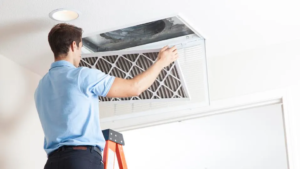Helena Roofing Contractor is a licensed person who works on roofs. This may be a person who is a sole roofer or employed by a roofing company.

They are able to assess a roof and offer a quote for the work required to repair the damage. They can also provide material warranties on shingles and labor.
Professional roofing contractors are trained to manage all aspects of a re-roofing project, including the coordination of different subcontractors and suppliers. They are also able to estimate costs for materials and the amount of time it will take to complete the work, which allows them to provide accurate pricing.
They are experienced in completing large scale projects and can easily adapt to changing circumstances and unexpected problems that may arise. In addition, they have the knowledge and skills to effectively communicate with clients to understand their needs and expectations for the project. This helps them to deliver high quality results that meet and exceed client expectations.
Roofing contractors also have the expertise and equipment to carry out roofing jobs safely. For example, they can use sponge pads and special footwear to avoid falling debris and other dangers. They are also familiar with the requirements of New York’s new roofing law and can draft contracts that comply with these regulations. They can also offer their clients a wide range of building products and materials at competitive prices.
If you are unsure whether a contractor is a roofing specialist, ask to see their credentials and references. Generally, they will be able to demonstrate their professionalism with pride and will be happy to share their previous work. Those that cannot provide references should be considered “storm chasers” and are likely to do poor quality work or disappear after collecting their payment. In contrast, local roofing specialists have earned standing with manufacturers and can offer substantial warranties for their services.
Experience
Experience is a key trait to look for in a roofing contractor. An experienced contractor will know how to handle all aspects of the re-roofing process and will have a vast knowledge of the various roofing materials that can be used. They will also be able to anticipate challenges that may arise during the project and address them accordingly, ensuring the job is completed on time and within budget.
Having experience as a roofing contractor also allows them to accurately assess the project and provide you with a realistic timeline for completion. This is important because if a contractor gives you an unrealistic timeline, it could result in the work being done poorly or even incompletely.
A good roofing contractor will be able to demonstrate their skills and expertise through examples of past projects. They should be able to explain what went well and not so well on previous jobs and offer solutions for any issues that may have arisen. If they are unwilling to show you this evidence of their competence, it is a red flag and you should steer clear.
An experienced roofing contractor will also be able to provide you with a comprehensive warranty for their services. This will give you peace of mind that you are getting quality workmanship and the best possible service for your money. This warranty will cover any repairs that may need to be made after the installation of your roof.
In addition, an experienced roofing contractor will be able to provide you with detailed estimates for the work that needs to be done and the materials that will be required to complete the project. They will also be able to advise you on any special considerations that need to be taken into account, such as inclement weather or other factors that might impact the completion of the work.
Roofing contractors also often specialize in other parts of the home that work with the roof or are closely linked to it, such as windows, sidings and insulation. This ensures that you have a single company that is expert in all the areas of your home exterior. This will simplify the overall management of the project and will help reduce costs by avoiding the need to hire multiple different contractors for each individual aspect of the work.
Warranty
A reputable roofing contractor should always be willing to back their work with a warranty. They should be able to offer a warranty for both their workmanship and the materials they use on your roof. This will give you peace of mind that if something goes wrong with your roof, they’ll take care of it. However, it’s important to understand the terms and conditions of your warranty. There are many things that can void it, including failing to set a reminder to get your roof inspected on a regular basis, bringing in a different contractor to do maintenance, or failing to register your warranty. Make sure to read the fine print and ask questions about your warranty before you hire a roofing contractor.
Most manufacturers will offer a material warranty on their products. This is typically good for a limited time period, and covers any defects in the product. However, it is important to remember that the basic manufacturer warranty does not include any type of coverage for labor or installation errors. To avoid having your warranty voided, be sure to stay with the original roofing contractor for all future maintenance and repairs, or opt for an enhanced warranty that will cover both labor and installation errors.
There are also several things that can void a manufacturer’s warranty, and these are generally specific to your location. For example, hail damage isn’t covered by most warranties unless you add on an extra protection plan, and high winds can cause structural damage to your roof that isn’t typically included in your warranty.
Some manufacturers allow a warranty to be transferred to a new homeowner, but the transfer process can be complicated. There are often deadlines and fees involved that must be met to ensure that the warranty will be valid for the next homeowner. It’s best to start this process well before the sale of your home, and to contact both the contractor and manufacturer to ensure that all necessary paperwork is in order.
Many roofers will offer their own warranty on their work, which is separate from any manufacturer warranty. This is a great way to guarantee your satisfaction and may cover issues that are not covered by the manufacturer’s warranty. These can include leaks that occur within a certain amount of time after the roof is installed, as well as installation errors.
Safety
Safety measures are crucial to a roofing contractor’s work. They should have a thorough training program for all employees, including specific safety protocols for each type of roof. Training should also cover the risks posed by weather conditions and the proper use and maintenance of tools and equipment. Finally, it should educate employees on handling hazardous materials that may be present on or near a roof.
A roofing contractor is required to follow the occupational health and safety standards set by OSHA. This includes providing appropriate personal protective equipment (PPE) and ensuring workers are trained to use it correctly. PPE may include rubber boots, ear protection, eye protection, a hard hat, and safety gloves. It is also essential to provide adequate ventilation and a safe working area when possible.
Roofing contractors must also ensure the area around the job site is free of hazards. This includes removing any potential trip or fall hazards like nails, screws, debris and other waste. This also includes securing access to the roof so that only authorized personnel can enter or work on it. Moreover, a good roofing contractor will ensure that people living in a home during a roof installation are informed of the work and take steps to avoid disruptions or accidents.
It is important to remember that a roofing project can be very dangerous, especially for new or inexperienced roofers. This is why hiring a roofing contractor with a good track record is essential to the success of the job. A reputable roofing company will be transparent about their safety certifications and training programs, as well as their commitment to the well-being of their employees.
A focus on safety protocols also translates into quality workmanship. This is because a roofing contractor that prioritizes safety will be likely to adhere strictly to established procedures and guidelines. This will ultimately result in a superior finished product for the homeowner. For more information on the safety of your roofing project, contact a trusted safety consultant.








